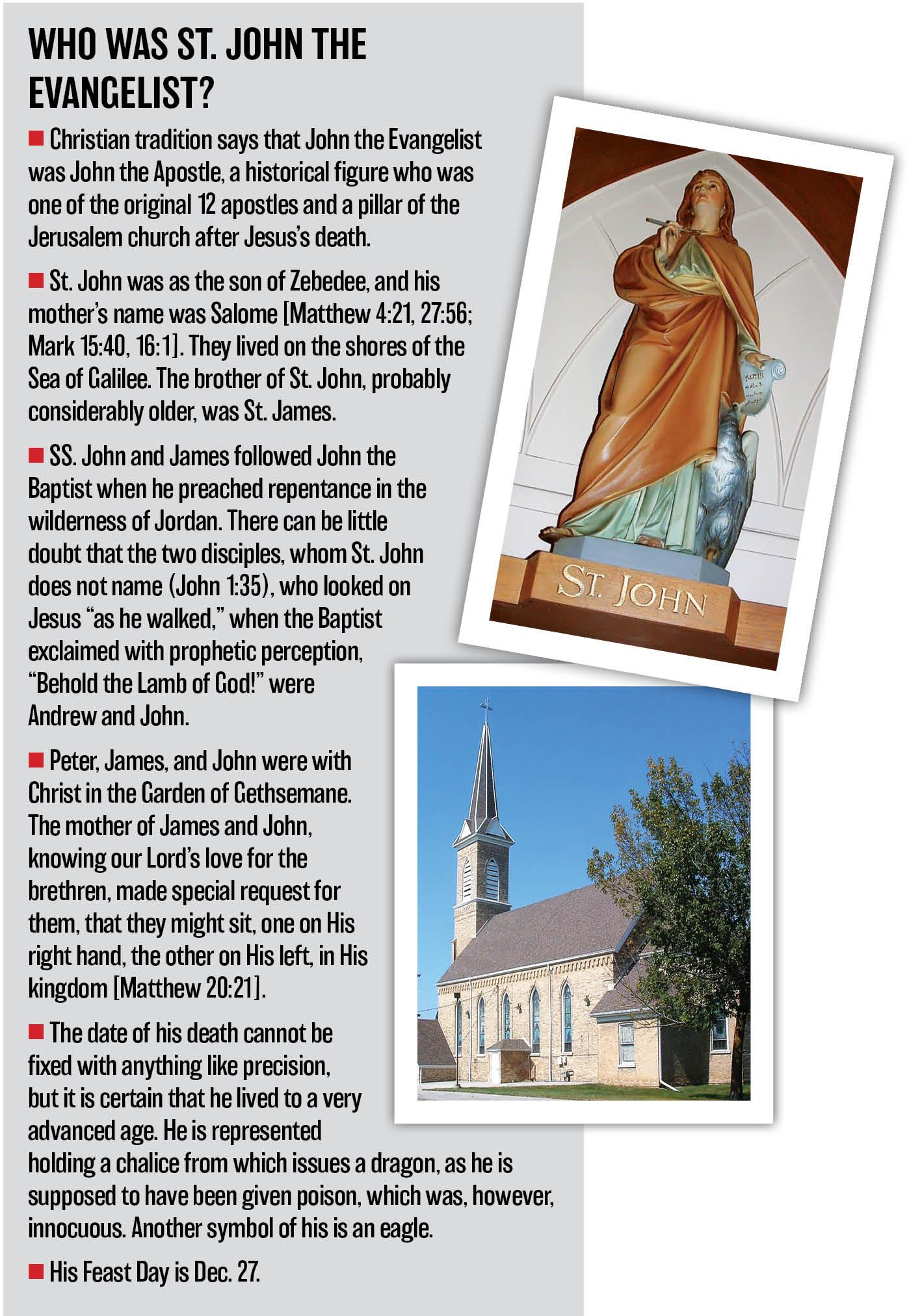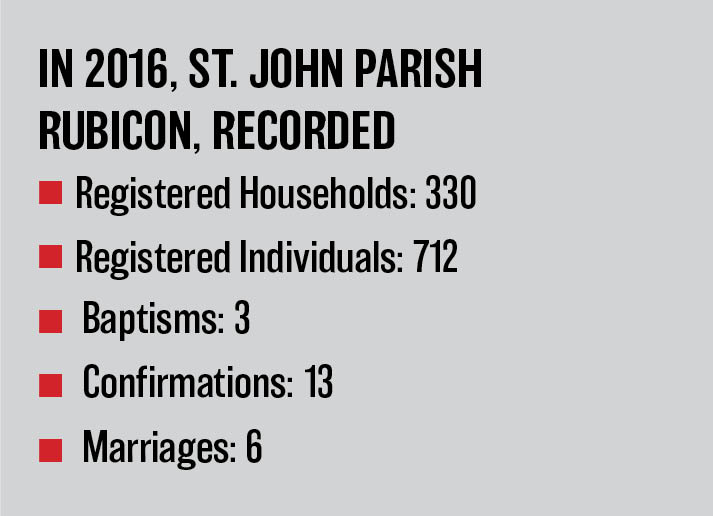As you make your way through the beautiful Dodge County countryside toward the small town of Rubicon, you can spot the St. John’s steeple from nearly a mile away. It stands tall above the rolling hills and groves of oak and maple trees with leaves now beginning to reveal their autumn yellows, oranges and reds on these sunny afternoons.
In 2020, St. John Catholic Church will celebrate its 150th year as a site of worship and warm, welcoming community. The church’s 125th Anniversary history book states, “We have been observing the way the grace of God turns in our lives, day after day, year after year, generation after generation. That wise man of the Bible, Qoheleth, reminds us about this when he wrote, ‘to everything there is a season.’ The seasons of the year turn around the liturgical seasons of the church, all of them bringing us closer the Kingdom of God and closer to one another.”

Top: St. John. Above: The outside of St. John. (Photos by Tom Andrews)
And so the traditions and great German heritage of this tiny rural community beckon those of faith to come and worship.
“One of the things I knew about St. John almost from the start is that it’s steeped in traditions with its German heritage and its many farmers of different kinds,” said Fr. David La Plante, who is pastor at both St. John and at St. Kilian in nearby Hartford under an archdiocesan cooperative arrangement. “They’ve had long-term pastors. Fr. Francis E. Weis was here for 39 years (1933-72) and the pastor before me was here for 12 years. It’s the only church in a small town. Most of the members of the parish are parts of families. Between about four family names you take in just about everyone who belongs to St. John. The most notable membership are people who have been coming here for many generations.”
The first Masses in the area were said to be celebrated in log cabins in 1851 and the local residents talked about the first little log church in the town of Herman, located between Rubicon and Woodland. As the first missionaries and settlers began to move into the area, a church for settlers was built in St. Lawrence, about 10 miles away. Mass goers made that trip from 1846-54, when a new log church (Old St. John’s) was built in the town of Herman on donated land in 1863. A school house was erected in 1862 thanks to a donation of $332 by 33 people.
Old St. John’s received its first resident pastor in 1875, Fr. Michael Beitter, who came to the U.S. from Bavaria. Catholics in Rubicon were pleased to now have a church to attend and a resident pastor willing to serve. Yet, they longed to have their own church. That meant they’d either have to separate from Old St. John’s in Herman or somehow convince the town of Herman Catholics to unite with a more centrally located church.
Christmas Day 1869 would prove to be a double cause for celebration as Fr. D.F. Thill (who was only 25 years old at the time) announced that the church in Herman would be moved to the village of Rubicon. The search was on for a new site and was soon built on 5 acres of donated land. More key historical milestones would follow with the building of a new school (1885), a new tower added to the church (1886), installation of Fr. William Pickery as the first resident priest (1902) and the church being remodeled and frescoed to prepare for the Golden Jubilee (1918).
In 1933, St. John had no pastor for eight months so the Carmelite Fathers of Holy Hill saw to the needs of the parish. Later that year, Fr. Francis E. Weis took over as pastor, bringing with him a sharp focus on education. In 1945, the church built a high school and toasted its first graduating class in 1948. It was the only tuition-free Catholic high school in rural Wisconsin.
But the high school closed in 1967 due to a shortage of nuns to teach. The elementary school shut its doors for the same reason in 1969 and declining health forced Fr. Weis to retire in 1972. Six years later, the school and convent were taken down.
The beauty of the Rubicon area complements many historic and fascinating sights on the church grounds. Indeed, visitors have much to see before even going inside the church itself. On the downward slope behind the church and to the east is a century-old cemetery which features a Sacred Heart Monument standing 18 feet high and composed of solid stone and concrete.
Behind the church building, one can pause before the Lourdes grotto of the Blessed Virgin, which was built in 1916. In May of that year, parishioners were requested to gather stones for its construction. Three weeks later, 180 loads of the best specimens and rarities were hauled to the north side of the church and the grotto became reality.
Immediately to the west of the church entrance, visitors can discover the glass encased Stations of the Cross, which were erected in 1917. The chapels that contain the stations are 10 feet high and the figures behind the glass are each 3 feet high. The Stations of the Cross are maintained by local neighbors.
Then, of course, is the church itself. It’s a visual treat, especially for those who enjoy typical German Gothic architecture complete with Milwaukee cream brick exterior.
“At St. John, you’re going to see a church that has been here for over a century,” Fr. La Plante explained. “The stained glass windows behind the altar are significant and the choice and number of the saints represented in the church is very significant because these were the popular saints of the time. You’re going to see a school and a hall which are part of a long tradition of school which no longer exists but is now a religious education Catechetical Center and social center. People rent the place for weddings and it’s used for our annual parish festival.
“Rubicon is also a baseball town and the church is kind of related because the church’s buildings are the concessions stand for the community baseball field. So there is very much a community village feeling in Rubicon not just among Catholics but all of the people in the community.”
“We have wonderful fall festivals every fourth Sunday in September,” said Margaret Mary Schmidt, who was born in Rubicon in 1940 and has been part of St. John’s her entire life. “The parish people really work hard with things like the Baskets of the Heart. Last year, we had 75 baskets with very good items, including a $50 bill in some of them. We also have donut and pizza sales twice a year with 5-6,000 handmade pizzas. Everybody just works well together.
“I was baptized here, made my First Communion here and I was also married here,” Schmidt adds with a broad smile. “I also attended school here, all 12 grades when we had a Catholic high school here for a number of years. Fr. Francis Weis was here and he started up the high school and we really enjoyed it. I love coming to Mass at St. John and, even though I know a lot of people, there are always new people moving in.”
“I always tell people it’s the best church in town. It’s the only church in town and it has that sense of community,” said Fr. La Plante. “People at St. John are very welcoming and they like to see growth in the congregation.”
